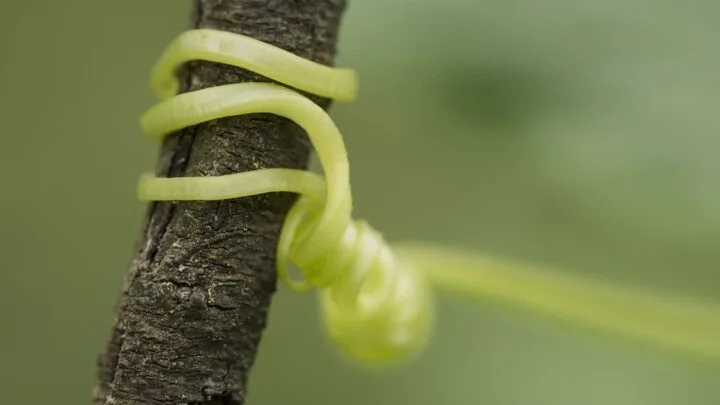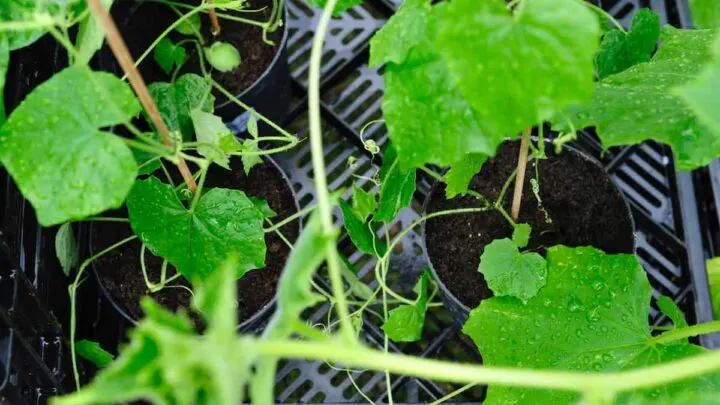Cucumbers, like other related plants such as squash and zucchini, develop tendrils in order to aid in their vining growth habit. Tendrils are an adaptation certain plants have to reach out for something to climb onto, usually in the pursuit of light. They help anchor the plant to the trellis, which ultimately aids in supporting the weight of the plant. This also helps keep the fruits off the ground and away from potential pests and diseases from the soil. So why would a cucumber plant have no tendrils?
A cucumber plant may lack tendrils due to genetic mutations or differences in varieties. Smaller cucumber plants may have not yet developed tendrils yet, though they may eventually form.
Fortunately, tendrils are helpful but not entirely necessary to the growth of your cucumber plant. Continue reading to learn more about how you can grow your cucumber plant without tendrils.

Why are my cucumbers not climbing?
Cucumber plants usually are grown on trellises to save space, make weeding more manageable, and keep the fruits off the ground and away from pests. But, this isn’t always the case.
A lack of tendrils will make it difficult for your cucumber plant to grab the trellis to begin its climb upwards. Sometimes, the tendrils aren’t developed enough and need a bit of help.
If your plant is young, then it is possible tendrils will eventually emerge, or if you are growing a bush variety of cucumbers, you may see fewer tendrils than the upwards growing vining variety. In either case, this issue can be remedied with relative ease.
Vines can be trained and secured loosely to the trellis while tendrils begin to develop, or in the case of plants lacking in tendrils entirely. To do so, you can use string, twine, or any similar implement you may have on hand. Gently but securely, tie the stem beneath the leaf to the trellis. You will likely have to tie in multiple places to keep the vines trained upwards.
If your plant has small or undeveloped tendrils, you can use the tie method until the tendrils fully form. After they have begun to grasp the trellis and seem secure, you can remove the twine. A lack of tendrils may cause issues supporting the fruits once they start to form, so a sling can be fashioned out of spare fabric to support the growing cucumbers.
Alternatively, cucumber plants can be grown horizontally with a bit of extra attention and space needed to keep them well maintained and healthy.

Can cucumbers grow on the ground?
Cucumbers can grow on the ground if growing vertically isn’t possible or desired. There are some disadvantages to growing cucumbers on the ground, such as an increase in susceptibility to pests and disease and a smaller yield.
Vertically grown cucumbers still have the same concerns, though they are usually slightly easier to deal with. Still, growing cucumbers on the ground can be done with ease and yield equally delectable results.
Bush varieties of cucumbers are better suited to growing on the ground since they have shorter vines that are easier to manage than their vining counterparts, with a more significant, more sprawling growth habit. Before getting the seeds, it is best to consider how you’d like to grow your cucumbers.
When growing cucumbers on the ground, it is essential to remember that fruits set on or near the soil are more susceptible to contamination and pest issues. These issues can be mitigated by frequent weeding and tending to the plant.
Another thing to consider is that the moisture settling on leaves when watering can lead to disease more often than plants that can be watered at the base without wetting the foliage.
Disease can take out an entire crop if not addressed and often can spread to other nearby plants, so it is important to be especially vigilant for this when growing cucumbers on the ground. Watering earlier in the morning instead of later evening hours can help keep moisture from sitting on your plant by allowing the sun to dry off the leaves.

Should cucumber tendrils be removed?
While cucumbers grown without tendrils aren’t necessarily at a disadvantage, removing tendrils from a plant could lead to less than desirable consequences.
Creating any open wound on a plant will open the door for potential infection, which can kill the whole plant. Tendrils grow at all places along the stem, so removing all of them would result in many tiny wounds throughout the plant.
Removing tendrils on cucumbers that are intended to grow upwards will lead to more effort to support and secure the plant to the trellis. Additionally, tendrils can photosynthesize just like other green parts on your plant, so leaving them on can help contribute to your plant’s available energy for flower and fruit production.
Even if you are planning on letting your cucumber plant grow horizontally, the tendrils should be left intact for the overall health of your plant.
Final Thoughts
Don’t be discouraged if your cucumbers aren’t growing tendrils. A lack of tendrils on your cucumber plant might be rare, though it is not a death sentence to your cucumber dreams if you encounter this issue.
It may take a bit more effort to get your cucumber plant to grow upwards or some more diligence if you prefer for them to be cultivated on the ground, but the result will be the same: fresh, home-grown cucumbers.
It is rewarding enough to grow something in your own garden, especially when you’ve had to conquer an unusual issue and emerge victorious.

Hi there, my name is Allie and welcome to my blog; GareningWithAllie!
Much of what you see written here is just our personal experiences with gardening. Along with the content I write here, there is also a unique collection of gardening topics covered by some of our close friends. I hope you find everything you read here to be helpful, informative, and something that can make your gardening journey the most lovely experience ever! With that said, Happy Gardening!
